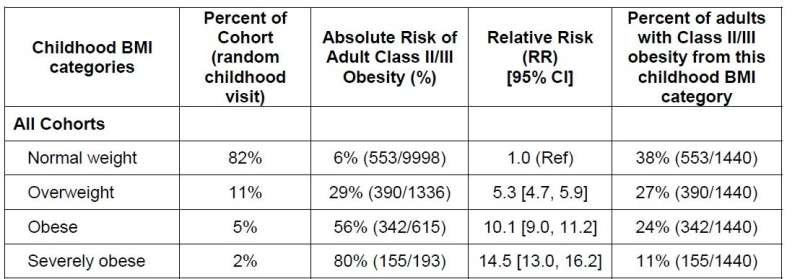Women and black Americans more likely to face severe adult obesity

Severe adult obesity carries many risks to health, but until now, little has been known about childhood risk factors involved. Now, a multi-national study led by experts at Cincinnati Children's shows how adult severe obesity risk rates vary by sex, race and other factors identifiable in childhood.
The study, led by corresponding author Jessica Woo, Ph.D., was published online Oct. 9, 2019, in the International Journal of Obesity, offers a predictive tool that doctors can use to focus intervention efforts on children and teens who are most likely to suffer health risks from obesity.
"Early prevention and treatment are critical, because severe adult obesity has significant adverse health outcomes, such as diabetes and heart disease," Woo says. "And unfortunately, severe obesity is rarely reversible, even with bariatric surgery."
More than 12,000 people tracked
This study focused on "adult class II/III obesity," defined as having a body mass index (BMI) of 35 and up. The team analyzed data about more than 12,000 people who enrolled as children in the International Childhood Cardiovascular Cohort Consortium in the 1970s and 1980s, then were tracked into adulthood.
At the beginning, 82% were children of normal weight, 11% were overweight, 5% were obese and 2% were severely obese. Around 20 years later, just 41% of the adults were normal weight, 32% were overweight, 15% were obese and 12% were severely obese.
Overall, obesity rates were higher among American participants than from other nations. Importantly, although the highest risks for adult severe obesity were among those with childhood severe obesity, more than one-third of the severely obese adults were normal weight as children.
"The risk of severe obesity in adulthood was substantially higher for girls than boys, for black participants than white, and for those with lower education levels," Woo says.
BMI trajectory charts for doctors
The study produced a series of figures resembling growth charts that doctors can use to show children and their families what their chances are of being obese in later years. For example, a 5-year-old white girl with obesity has a 60% chance of being severely obese by age 35, and an 80% chance of being severely obese by age 45.
The study could not answer, at an individual level, which children of normal weight were most likely to become severely obese in adulthood. The team did not have complete information on genetic and lifestyle risk factors. However, black girls emerged as having the highest obesity risks as a group.
"These findings suggest that greater clinical attention should be focused on both the prevention of childhood obesity at all ages, especially in girls and black populations, and to preventing children with normal weight in these groups from developing into adults with class II/III obesity," Woo says. "With tailored childhood monitoring through childhood, adolescence and young adulthood, it may be possible to prevent the high rate of progression to adult obesity."
More information: International Journal of Obesity (2019). DOI: 10.1038/s41366-019-0461-6


















